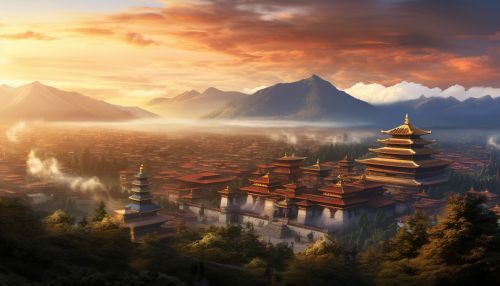Nepal
Geography
Nepal, officially known as the Federal Democratic Republic of Nepal, is a landlocked country located in South Asia. It is situated mainly in the Himalayan mountain range, with a diverse geography that includes fertile plains, subalpine forested hills, and eight of the world's ten tallest mountains, including Mount Everest, the highest point on Earth.


Nepal's climate varies with its topography and altitude. It ranges from tropical to arctic depending upon the altitude. The Terai region, which lies in the tropical southern part of the country, has a hot, humid climate. The mid-land regions are mild year round, ranging from cool in winter to warm in summer. The northern mountain region, around an altitude above 3,353 metres has an alpine climate with considerably lower temperature in winter.
History
Nepal's history dates back to the time of the Gopala Dynasty, in the 4th century BC. The Maurya Empire, under Emperor Ashoka, expanded into the region in the 3rd century BC. The Kirat Dynasty ruled the region from the 7th century BC, followed by the Licchavi Dynasty from 2nd century AD. The Malla Dynasty established in the 12th century brought about significant developments in arts and culture.
The modern history of Nepal began with the rise of the Shah Dynasty, and the founding of the Kingdom of Nepal in 1768. The Shah Dynasty ruled Nepal until 2008, when the country became a federal democratic republic following a decade-long Maoist insurgency and mass protests from several other political parties in Nepal.
Politics and Government
Nepal is a federal democratic republic. The President is the head of state and the Prime Minister is the head of government. It has a multi-party system. The Federal Parliament of Nepal is a bicameral parliament, consisting of the House of Representatives and the National Assembly.
Nepal's judiciary is composed of the Supreme Court, the Appellate Court, and the District Court. The Chief Justice of the Supreme Court is the head of the judiciary. The legal system of Nepal is based on a combination of Napoleonic Code, English common law, and customary law.
Economy
Nepal's economy is largely based on agriculture, which accounts for about one-third of the GDP. The country produces a variety of crops, including rice, wheat, maize, millet, barley, and oilseed. Livestock farming is also a significant part of the agricultural sector.
Tourism is another key sector of Nepal's economy. The country's rich cultural heritage, historical sites, and natural beauty attract tourists from around the world. Nepal is also a popular destination for mountaineering and adventure tourism, with the Himalayan region offering opportunities for trekking, rock climbing, and white-water rafting.
Culture
Nepal's culture is a blend of Indo-Aryan and Tibeto-Mongolian influences, reflecting the country's geographic position between India and Tibet. The country's cultural heritage includes a variety of music, dance, art, literature, and festivals. The official language is Nepali, and the official script is Devanagari.
Nepal is known for its distinctive art and architecture, which includes the unique Nepalese style of multi-tiered pagodas, stupas, and monasteries. The country is also home to a number of UNESCO World Heritage Sites, including the Kathmandu Valley, which comprises seven groups of monuments and buildings.
See Also


